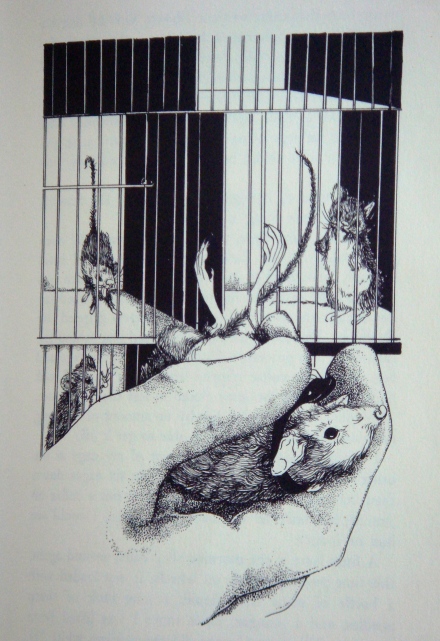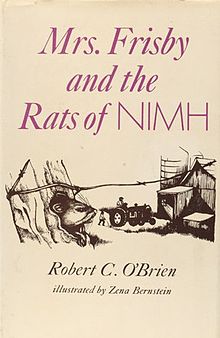Mrs. Frisby and the Rats of NIMH by Robert O’Brien
1971
Illustrated by Zena Bernstein
The story begins in an old-fashioned Beatrix Potter kind of way with a family of field mice living on Mr. Fitzgibbon’s farm. Mrs. Frisby, recently widowed, is anxious for her frail son, Timothy, who is delirious with fever. The family must move to their summer lodging before Mr. Fitzgibbons ploughs their field and upturns their home, but the chill spring air during the move might by more than Timothy can survive. Mrs. Frisby eventually seeks the advice of Nicodemus, the wise rat, and here the book takes a strange turn.
In the story-within-a-story centerpiece of the book, Nicodemus recounts a fantastical tale. Caught up in a sweep of a farmer’s market, the young Nicodemus was taken to NIMH (based upon the real National Institute of Mental Health) where he became a research subject in an experiment designed by the neurologist, Dr. Schultz. Nicodemus was one of a group of rats and mice who received DNA and steroid injections to boost their learning ability and slow their rate of aging. Taking advantage of their newfound knowledge (which included the ability to read the directions for opening their cage doors), they made their escape from NIMH, overwintered on an estate with a sizable library, happened upon a toy tinker’s truck which contained miniature tools and engines, and settled on Mr. Fitzgibbon’s farm where they constructed an elaborate burrow complete with electric lights, a working elevator, and a radio. Over time, Nicodemus developed moral qualms about a rat’s life of thievery, and a plan evolved to create a utopian Shangri-La of self-sufficiency in a remote valley.
The rats offer to help Mrs. Frisby move her home to safety, thus ensuring the salvation of Timothy. She, in turn, overhears Mr. Fitzgibbons talking about an impending visit of exterminators (it turns out that Dr. Schultz has gotten wind of their whereabouts), thus alerting the colony just in time for them to make their escape. There is plenty of excitement along the way, including the ever-present danger posed by Dragon the cat.
The book is unique in its combination of standard talking animal fare and futuristic super-rat fantasy. It is not only an arresting story, but also one that stimulates thought-provoking questions about intelligence, longevity, animal experimentation, genetic engineering, and ethics. It was in part for the book’s moral complexity that it was awarded a Newberry Medal.
